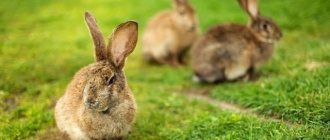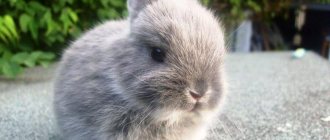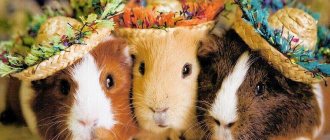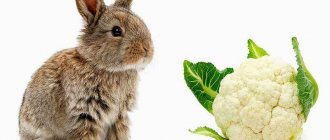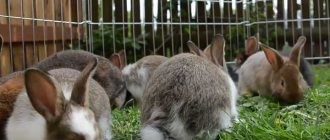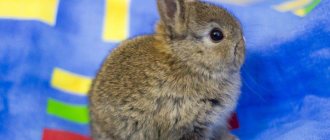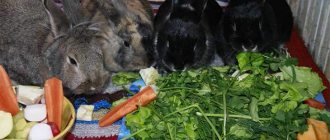How long do rabbits grow from birth to slaughter?
Rabbits grow very quickly; in this parameter they outperform all other animals. The most intensive growth occurs in the first 120 days. At 5 months, animals are already able to reproduce independently. By this time they reach 3 and even 5 kg. Many people are interested in how long it takes rabbits to grow; it is in the first 150 days that the most intensive growth occurs.
Rabbits are born completely blind and bald. Average weight 40–80 grams. In a month the mass increases 10 times. From this time onwards they may try to eat foods but still need milk. If the young animals leave the female rabbit earlier, there is something wrong with her milk production.
Californian and New Zealand white rabbits develop the fastest. Moreover, meat directions are significantly ahead of meat-skin directions in this parameter.
The growth rate directly depends on the quantity and quality of the rabbit's milk. Together with it, the body receives not only vitamins and nutrients, but also maternal immunity. Lactation depends on many factors, including:
- Conditions for keeping the female;
- age;
- season;
- number of litters;
- breed;
- brood size;
- lactation period.
The Soviet chinchilla is considered the highest-milk breed. At the same time, peak productivity occurs in the summer. During this period, the diet is as complete as possible with everything necessary for the animal itself and lactation. Among meat rabbits, the Californian breed takes first place. The female produces 100–200 grams of milk per day. Over the entire feeding period, one female rabbit produces 3–5 kg of milk.
To determine how quickly and to what age rabbits grow, they can be divided into three periods:
In the first period, the growth rate is high; from birth, the weight can increase 7–10 times. The second period is characterized by the fastest growth and weight gain. In the last period, weight gain slows down. Then it is reduced to a minimum. For different rabbit breeders, rabbits grow for different times before slaughter. If some consider the optimal age for slaughter to be 3 months, others keep it up to 5. At the age of 90 days, growth slows down significantly; from a business point of view, it is more profitable to raise a new generation. For small breeds, growth can continue for up to 6 months.
During the slaughter period, the rabbit should have the maximum amount of muscle tissue. The indicator differs depending on the type:
| Age category | 1 | 2 | 3 | 4 | 5 | 6 | 7 | 8 | 9 |
| Average weight depending on breed | |||||||||
| Large breeds (giants) | 700 | 1.5 kg | 2.6 kg | 3.6 kg | 4.6 kg | 5.4 kg | 6.1kg | 6.5 kg | 7.1 kg |
| Medium breeds | 500 | 1.3 kg | 2.2 kg | 2.8 kg | 3.4 kg | 3.8 kg | 4.1 kg | 4.5 kg | |
| Small breeds | 400 | 900 | 1.3 kg | 1.8 kg | 2.2 kg | 2.5 kg | 2.8 kg | ||
| Dwarf varieties | 200 | 400 | 600 | 800 | 1000 | 1.2 kg | |||
| Angora rabbit | 500 | 1000 | 1.5 kg | 2.0 kg | 2.5 kg | 2.9 kg | 3.2 kg | 3.4 kg | 3.5 kg |
Weight gain stops at different times depending on the breed. Rabbits grow until they are 8–10 months old. Average life expectancy is 5–8 years. The least profit comes from selling meat from animals under 80 days old. At this age, they eat a lot before slaughter; the business may not even pay off.
See a more complete rabbit growth chart:
The average price for an adult male is 800 rubles, for a female – 1000. The price includes dietary meat, fur and skin, and internal fat.
The cost of rabbits responsible for reproductive function is always higher. They must meet certain indicators, since it depends on them what the new generation will be like. The average cost is 2000–3000 rubles.
Source
List of breeds
Decorative miniature rabbits are so popular that breeders from different countries have bred a good two dozen breeds in just over a hundred years. Their names won’t tell an ignorant person anything, but if you decide to choose a beautiful and furry friend for yourself for many years to come, it’s worth understanding how individual species differ from each other. Let's take a brief look at the most common breeds.
The Dutch, also known as the Danish or Netherland rabbit, is the first colored breed, which made these animals incredibly popular. By the way, he is not so small - with a weight of about 2.5 kilos, he is simply a giant compared to other miniature brothers. It is recognized by a white wedge on its muzzle, pointed upward; at the bottom it turns into a white chest and the same front legs. The sides of the head, ears and back of the body are colored in a different tone, for example, black, blue or chocolate, the line of demarcation of colors is clearly visible. These calm animals learn well and live for about 10 years.
ALL RABBIT.RU
How fast do rabbits grow, rabbit growth chart
How fast do rabbits grow? In terms of early maturity, rabbits are superior to other farm animals. They grow intensively during the embryonic period and the first 3-3.5 months after birth. They reach sexual maturity by 4-5 months, and their live weight by this time should be at least 3.5 kg.
First actions after birth
Immediately after the birth of the rabbits, it is necessary to clean the cage of dirty bedding and droppings.
After birth, babies need proper care, mother's milk, correct temperature conditions, as well as a lot of care and affection.
They carry out an examination: the healthy ones are put aside, the sick and sickly ones are tried to be resuscitated. The dead must be disposed of immediately, since they are a direct source of pathogenic microflora.
At this stage, it is important to carefully monitor the behavior of the female and how she cares for her offspring.
They should not be disturbed by other animals. It is also important to keep the cage clean. The female should always have fresh food in sufficient quantity and clean, warm drink, since rabbits constantly drink water after eating.
Inspection of the offspring must be carried out very delicately; the female must not be stressed. Before the procedure, wash your hands in warm water with an odorless detergent.
How fast do rabbits grow, rabbit growth chart
Rabbits are born blind, naked and helpless, weighing 40-80 g; by the end of the 4th week their live weight increases 10 times. By the end of the first day, the rudiments of primary hair are formed on the head, on the 5-7th day hair appears on the entire body, by the 20-25th day its development is completed, and then gradually begins to be replaced by secondary hair. By the time of puberty, this process is completed. On the 10-14th day, the rabbits begin to see clearly, and on the 15-20th day they can already leave the nest and eat food on their own (the exit of the rabbits from the nest at an earlier age indicates the low milk production of the female rabbit).
Rabbits of the Californian and New Zealand white breeds are distinguished by particularly high growth energy.
In terms of growth intensity, rabbits of meat-hide breeds are inferior to rabbits of meat breeds.
Feeding 2 month olds
The diet of animals at the age of 2 months should be nutritious and varied. The rabbits are offered green food - chamomile, plantain. They also provide root vegetables and branches of fruit trees.
Young animals should be fed gradually and in small doses - during the introduction of new feeds, the intestinal reaction should be carefully monitored. If diarrhea occurs, they are immediately returned to breast or bottle feeding and maintained on this diet until complete recovery.
You cannot feed animals food from the table. Bread, weak foods, and pasta can cause indigestion and death.
Fattening rabbits for weight gain
Plant and feed impurities are introduced into the food of rabbits from 2-3 months. The composition of feed at each age stage is different.
Without special fattening, the farm will not only remain without profit, but will not even recoup the costs of maintaining the long-eared animals.
The process of feeding rabbits involves three stages:
- preliminary (selection of a suitable diet);
- main (weight gain in pets);
- final (adjustment of weight and body fat).
The first period is characterized by increased nutrition of young animals.
In summer and winter, it is based on combined mixtures:
The preparation stage is 5 days.
The main stage is aimed at the formation of the fat layer.
Animal nutrition includes foods containing fats:
Porridge with milk is added to the rabbits' daily diet. The fattening period lasts 7-10 days.
The final stage involves maintaining the animals' appetite.
The liquid is salted, and seasonings from:
Constant monitoring is carried out to ensure that pets eat the required amount per day.
In the last days of feeding, hay and grass are excluded.
Amount of feed for fattening
The use of exclusively mixed feed is typical for industrial fur farms. For a mature individual, consumption per day is 100-110 g of feed, in which 55% is grains, corn, oats, 45% is cake and bran.
The nutrition of rabbits becomes complete due to the inclusion in the daily diet, in addition to compound feed, of auxiliary feeds, which are divided by type:
- green - a combined group of fresh plants (grass, tree leaves);
- juicy – represented by fruits and vegetables;
- coarse - hay.
Attention! The need for concentrated feed depends on the time of year, gender and age of the animal.
With mixed feeding, the dosage of feed per day is half as much (40-50 g), with the exception of:
- puppet females, who are prescribed 90 g in summer, 100 g in winter;
- nursing rabbits - 130 g in summer, 150 g in winter.
Table 1. Annual feed requirement for combined fattening
| Type of individual | Stern | Quantity (kg) |
| Nursing female (24 rabbits) | Compound feed | 342 |
| Hay | 109 | |
| Silage, root crops | 90 | |
| Fresh grass | 420 |
Feeding cages for rabbits
The dimensions of the feeding cages are determined by:
- number of young animals;
- number of mature rodents;
- place where animals are kept.
General principles for organizing animal housing:
- Thoughtful location of the territory for maintenance (without drafts and strong winds).
- Choosing wood as a material for the frame and supports, for walls - plywood or mesh.
- Keeping males separate from pregnant female rabbits and their joint offspring.
- Typical cage parameters for an adult are 1500x700x700 mm.
Table 2. Minimum sizes for keeping pets
| Classification | Standard area per head (sq. m) | Length(cm) | Width(cm) |
| For the main herd (two-section) | 1st section – 0.5-0.62nd section (nesting compartment) – 0.18 | 60-7050 | 9036 |
| For females (for 4 individuals) | 0,15 | 90 | 672 |
| For males (for one) | 0,605 | 90 | 672 |
| For young animals | 0,13-0,16 | 29-36 | 45 |
During the birthing period, the cubs are kept together with the female rabbit until they become stronger. For ease of cleaning, feeding boxes are made retractable or hanging.
The finished cells are placed at a distance of 20-50 cm from the floor. This will protect young rabbits from rodents.
Preparation for slaughter
It is advisable to have rabbits examined by a veterinarian in order to cull sick animals. Isolation should be carried out - individuals selected for execution should be placed in a separate small cage for a day.
In order for the animal to cleanse its intestines, you should stop giving it food no less than 10-12 hours from the expected time of slaughter. You can extend this period by a day. They continue to give water not to quench thirst, but to remove feces from the body.
Before slaughter, you need to wash the rabbit and let it dry. Rabbits are shy animals, so you need to choose a quiet, calm place for slaughter. There should be no strangers or other pets there.
You should prepare all the necessary tools in advance and protect the surface from traces of blood with film. The worker must wear an apron and gloves.
Methods of raising rabbits for meat
Animal nutrition is the basis of rabbit breeding.
Two methods are used for fattening rabbits:
In large and medium-sized farms containing 200 animals or more, both technologies are being introduced simultaneously. In homesteads, the usual method of feeding is used.
Broiler method of breeding rabbits
The peculiarity of the method is the short period of feeding the young animals and the savings on cages. One fattening cycle takes 90 days.
Feeding rabbits at home is not complete without hay and branches of various trees.
During feeding, the rabbits remain with their mother. After finishing fattening, the female is transferred to the male for mating. In a year, a female rabbit gives birth to up to 24 babies.
This is interesting! The skin of broiler rabbits is inexpensive, but the meat is in great demand due to its nutritional value and taste.
Advantages of the broiler method:
- there is no need to equip group cells;
- concentration of livestock in one place allows for quick care of rodents;
- with constant feeding on mother's milk, the baby rabbits reach a weight of 3-4 kg by the third month;
- raising two hundred females at the same time produces about 8 centners of pure meat per year.
The intensive breeding method depletes the immune system of females and reduces milk production. Lack of sanitary standards during feeding leads to disease of the mammary glands in the rabbit.
The percentage of concentrated impurities for a nursing female is 45-50% in summer and 65% in winter. For the growth of young animals, 155 g of protein is added at each feeding. Water is included in the diet in unlimited quantities.
Common method of fattening young rabbits
The use of conventional fattening involves the removal of young animals from their mother after two months. While the cubs are on suction feeding, the female rabbit is provided with intensive 5 meals a day.
The basis of nutrition for rabbits is concentrates. In the first week, at least 500 g of food is consumed per pet, of which 450 g is a legume-cereal mixture, 50 g is grain.
By the third and fourth months, the volume of feed increases by one and a half, two times. At slaughter, the daily norm (800-950 g) remains the same.
This is interesting! Conventionally fed rabbit meat does not have high nutritional value. The sale of fluffy animal skins brings great profit to breeders.
At five months or six months of age, the animal is sent to slaughter. By this time, body weight reaches 4-5 kg.
Disposal and Sanitation
The skin of rabbits and their blood retain pathogenic microbes for a long time, so after slaughter it is necessary to sanitize the premises, clothing and tools. It is also necessary to dispose of any leftovers from the animal.
What you need to do at home:
- Thorough cleaning of the premises. Sweep and mop the floor using water pressure.
- Disinfection. We offer two options for treatment with steam or special means, for example, based on hydrogen peroxide or alcohol.
- Skin processing. Follow all dressing rules.
- Recycling. Burn everything you have prepared for disposal.
- Disinfection of equipment.
Pathogenic microflora rapidly spreads throughout the area, therefore, if the above measures are not taken in time, the likelihood of infection of other rabbits, livestock and humans increases.
Increasing the weight of rabbits using additional methods
Rabbit breeders with extensive experience use auxiliary methods to activate weight gain in their pets.
The basis of the winter diet of rabbits is roughage and concentrated feed.
Additional productive methods that ensure weight gain in animals include:
- Rational seating of rabbits. In a herd, animals are divided into stronger and weaker ones. All pets need to receive food in equal portions. To do this, you need to group rabbits taking into account their temperament.
- Limited space. The mobility of rabbits is limited by the small area. With minimal movement, rabbits can quickly gain weight.
- Monitoring the filling of the feeder. After each feeding (4-5 times a day), the food container is cleaned. Empty food boxes are filled again.
Breeders successfully take advantage of another feature of rodents - activity at night. Shielding the cage from daylight increases the rabbits' need for food. But regular exposure of animals in semi-darkness is contraindicated.
Bleeding and flaying
After slaughter, a bleeding procedure is carried out. The rabbit carcass is hung by its hind legs over a container upside down to collect blood. Next, the head of the killed animal is cut off between the back of the head and the first cervical vertebra or the jugular veins are cut. Both methods work great to drain all the blood in less than 5 minutes. After bleeding, skinning is carried out and the skin is removed from the body. You need to peel the skin while still warm so that it is smoother and it is easier to stretch it on the spacer.
Before skinning, you need to wash off the dirt and blood residue from the fur and comb the fur. They begin to skin the carcass from the hind legs using a sharpened knife. The fur near the hind legs is cut in a circle, then an incision is made from paw to paw in the center of the anus. The rabbit skin turned inward is slowly pulled down to the forelimbs. If areas of strong tendons and fatty deposits are found, they are carefully cut with a knife.
Nutritional supplements for artificial weight gain
To improve appetite, breeders add vitamins to pet food. Beneficial substances of groups A and E are used together with fats, vitamin D is added to thick and porridge-like food. The drink is diluted with vitamin C.
After consultation with a veterinarian, animals are prescribed vitamin-mineral, as well as protein-vitamin-mineral supplements (PVMD).
They strengthen the animals’ bodies with useful microelements: manganese, calcium, phosphorus. Protein-containing options provide protein to the animal's muscles.
Vitamin and protein supplements have no contraindications. The correct dosage is calculated taking into account the body weight and age of the pet. The use of additives above the norm worsens the taste characteristics of rabbit meat.
Feeding grown-up individuals
The diet of the younger generation differs in many ways from the diet of adults. Compound feed is given in limited quantities, because this product contains a lot of fat and harmful substances that can negatively affect the health of young animals.
The diet of rabbits should be nutritious and easily digestible
In winter, the diet consists of the following components:
- concentrates - 5-65%;
- straw and dry grass – 10-20%;
- succulent feed - 20-30%.
The summer diet includes:
- forbs - 30-40%;
- concentrates - 60-70%.
Other Important Points
Breeding rabbits for meat always begins with determining the breed that is most suitable for these purposes. Today, the choice of lines is very large, but domestic professionals in the field of rabbit breeding advise giving preference to one of the following breeds - white or gray giant, Belgian Flanders, ram, New Zealand breed, butterfly.
The choice of breed is based on the following criteria:
- precocity of the breed;
- meat yield as a percentage;
- taste characteristics of rabbit meat;
- daily weight gain.
In addition to nutrition, the living conditions of the animals play a huge role in raising rabbits for meat. The cages must be spacious, protected from the sun and wind, and must be clean and comfortable. Unsanitary conditions negatively affect the rabbit's health, and its weight in this case increases extremely slowly.
In general, only animals that are in good health are raised well. Therefore, do not forget about mandatory vaccination and regular examination of eared animals.
Rules of care
In the process of growth and development, small rabbits need care and attention:
- First of all, they need to provide warmth and cleanliness. Therefore, as contamination occurs, the room is cleaned and disinfected. To eliminate the risk of hypothermia, the litter should be changed regularly, as it quickly gets wet and becomes cold. The place where rabbits are kept should always be dry and clean. The optimal temperature regime for keeping young animals is 30°. At lower temperatures they become restless and squeak.
- Young individuals should be constantly monitored - with a decrease in activity and mobility, there is a high probability of contracting some kind of disease. It is important to detect it in time and take appropriate treatment measures.
- A drinking bowl with clean water should be installed in the cage. The water is changed several times a day.
Is it worth starting a business?
Breeding giants is considered a promising area for business, but novice farmers admit that the task is not an easy one. Rabbits live in cages, so it is necessary to choose a spacious structure inside which the individual can rise on its hind legs. Having free space is one of the most important conditions for the quality growth of any breed.
To make the rabbit comfortable, the floor of the cage is covered with sawdust, straw, and hay. From time to time you need to add fruit branches so that the rabbit can gnaw on a hard object. To regularly feed the animal, it is necessary to provide a feeder and a large drinking bowl. The fluid is changed daily - this is the key to the health of the individuals. Bowls for rabbits are more suitable for heavy ones, as the animals can turn them with their nose.
In order for the female to give a normal birth, one of the corners must be equipped with a heating system - this is what she will choose for giving birth. The fertility of modern breeds is quite high, birth control is not required, and small cubs at birth weigh no more than one hundred grams, but their number often reaches 7, and sometimes more. In just a month and a half, the weight of the young animals will increase to one and a half kilograms. To avoid diseases, it is necessary to keep the cage clean - bacteria are dangerous not only for people, but also for rabbits.
Female behavior
To prevent the female from scattering the rabbits and refusing to feed them, she should not be allowed near the males. Otherwise, she will lose her maternal instinct and may become pregnant again. Because of this, the female often abandons her babies; sometimes you can observe a terrifying situation when a female rabbit tramples, scatters her babies, or even worse, eats them.
Any disturbance in the female can also lead her to aggression. The female rabbit reacts negatively to various noises to the point that she can not only scatter her offspring, but also abandon them. Therefore, the cage must be installed in a quiet and peaceful place.
Common Causes of Early Death
There are a number of recommendations that will help to significantly increase the life expectancy of decorative rabbits.
- do not give the animal food from the common table (sweets, meat, bread, crackers);
- in order to prevent the development of colds, do not let your pet walk in a draft or near heating devices;
- Babies need to be bathed extremely rarely; after bathing, the baby rabbit needs to dry thoroughly, so keep it in a dry towel until completely dry;
- do not allow the animal to be injured, so do not drop or step on the pet;
- to grind down the incisors, which grow throughout their lives, rabbits need to be given information from trees and shrubs;
- domestic rabbits have difficulty withstanding high temperatures, stuffiness, high humidity and dampness;
- hay, like other products, should not be rotten or wet;
- It is recommended to accustom animals to new products gradually;
- domestic eared cats need vitamins and minerals;
- The water in the sippy cup should be clean and at room temperature.
Any pet needs attention and affection. Then the question of how many years decorative rabbits live will disappear on its own. An active and playful animal lives to the maximum.

